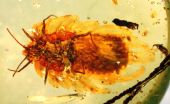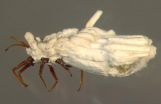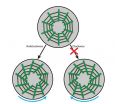(Press-News.org) Scientists at the University of Bonn, together with colleagues from China, UK and Poland, have described the oldest evidence of brood care in insects: it is in a female scale insect with her young that is encased in amber as a fossil. The approximately100-million-year-old "snapshot" from the Earth's history shows the six millimetre long tiny insect with a wax cocoon, which protected the eggs from predators and drying out plus associated young nymphs. The researchers are now presenting their results in the respected journal eLIFE.
The small female insect with the waxy cocoon or reticulum is clearly visible in the brownish translucent amber. The wax cover protected both the scale insect and her approximately 60 eggs from predators and from drying out. In contrast to male scale insects, the female has no wings and is specialized to suck on leaves and provide for her offspring.
"Fossils of fragile female scale insects are extremely rare", says Chinese paleontologist Dr. Bo Wang, who as a fellow at the Alexander von Humboldt Foundation researching at the Steinmann Institute of the University of Bonn. "What is unique here is the age of the discovery: 100-million-year-old evidence of brood care among insects has not been found until now." The age of the site of the discovery was determined using the radiometric uranium-lead dating method. In addition to the insect, its eggs and the waxy cover, six young insects are also preserved in this "snapshot" of the Earth's history captured in amber.
The fossil is named after a Buddhist goddess
Dr. Wang used his good contact with collectors in northern Myanmar to find this extraordinarily rare amber inclusion. The international team of scientists gave the 100-million-year-old scale insect the name "Wathondara kotejai" - after the Buddhist earth goddess Wathondara and the Polish entomologist Jan Koteja.
That the female scale insect was preserved in amber was a very rare occurrence, explains Associate Professor and co-author Dr. Torsten Wappler of the Steinmann Institute at the University of Bonn. Usually, it is the male scale insects that are encased by the resin when they stop on the trunks or branches of trees. In this case, resin probably dripped from a branch onto a leaf which enclosed the female scale insect with her cocoon, eggs and nymphs.
Then the resin fossilized. The scientists cut and polish the amber until only a thin layer remained over the enclosed insect. Like looking through a window, the researchers were then able to take three-dimensional, high-resolution photographs of this witness of the past under the microscope.
Brood care increases the survival chances of the offspring
"With brood care, the scale insect increases the survival chances of its offspring", says Dr. Wappler. Once the young scale insect is far enough along in its development, it slips out of the protective wax coating and looks for a new plant where to suck its high-sugar and high-energy sap. Even today, common scale insects have a wax cocoon. Their wax gland is found on the hind end. While turning in circles, they discharge the secretion. The result is a round structure with grooves. "The wax case then looks sort of like a record album from the top", says the paleontologist with a grin. If the animal grows, it moults and discharges wax again. Skin and wax layers therefore alternate in the cocoon.
Amber as a window to the past
From comparing modern scale insects with the amber discovery, the paleontologists concludes that the lifestyle and reproductive behaviour of these insects around 100 million years ago was already quite similar to the current forms. "Inclusions in amber are a unique opportunity to look at life in the past", explains Dr. Wappler. Insects in fossilized resin are usually very well preserved, whereas articulated animals embedded in sediment either do not remain intact at all or are often crushed or crimped by the pressure of the weight of the overlying layers. "That is why the amber discovery of Wathondara kotejai is unique", the scientists at the University of Bonn are convinced.
INFORMATION:
Publication: Brood Care in a 100-million-year-old scale insect, Journal eLIFE; DOI: 10.7554/eLife.05447.001, Internet: http://dx.doi.org/10.7554/eLife.05447.001
Media Contact:
Dr. Bo Wang
Steinmann-Institut der Universität Bonn
Nanjing Institute of Geology and Palaeontology
Chinese Academy of Sciences (Nanjing/China)
Tel. ++49-(0)228-734682
E-Mail: savantwang@gmail.com
Associate Professor Dr. Torsten Wappler
Steinmann-Institut der Universität Bonn
Tel. ++49-(0)228-734682
E-Mail: twappler@uni-bonn.de
Face recognition security on smartphones can be significantly improved if users store an 'average' photo of themselves, according to new research by scientists at the University of York.
A research team led by Dr David Robertson, of the Department of Psychology's FaceVar laboratory at York, found that combining different pictures of the user, rather than a single 'target' image, leads to much better recognition across all kinds of daily settings. The research is published in the journal PLOS ONE.
The researchers examined the performance of the 'face unlock' system ...
Researchers at the Mechanobiology Institute (MBI) at the National University of Singapore have discovered that the inherent 'handedness' of molecular structures directs the behaviour of individual cells and confers them the ability to sense the difference between left and right. This is a significant step forward in the understanding of cellular biology. This discovery was published in Nature Cell Biology on 23 March 2015.
Cellular decision making
Our bodies are made up of hundreds of different types of cells, each of which performs a unique and highly specialized ...
Researchers from the UK and Malaysia have detected a human fingerprint deep in the Borneo rainforest in Southeast Asia. Cold winds blowing from the north carry industrial pollutants from East Asia to the equator, with implications for air quality in the region. Once there, the pollutants can travel higher into the atmosphere and impact the ozone layer. The research is published today in Atmospheric Chemistry and Physics, an open access journal of the European Geosciences Union (EGU).
Rainforests are often associated with pure, unpolluted air, but in Borneo air quality ...
WASHINGTON-- The Society for Public Health Education (SOPHE) proudly announces the publication of a Health Education & Behavior (HE&B) supplement devoted to the latest research and practice on policy and environmental approaches to foster healthy communities. The April 2015 supplement, "The Evidence for Policy and Environmental Approaches to Promoting Health," comprises a dozen peer-reviewed articles and two perspectives examining the state-of-the-evidence on what's working and what's needed at the community, institutional and societal levels to promote good health across ...
A world first study revealing the presence of two antibodies in a sub-group of children experiencing their first episode of psychosis affirms a longstanding recognition that auto-immune disorders play a significant role in psychiatric illness.
Antibodies defend the body against bacterial, viral, and other invaders but sometimes the body makes antibodies that attack healthy cells. In these cases, autoimmune disorders develop. These include conditions such as multiple sclerosis (MS), rheumatoid arthritis and Type 1 diabetes.
This 'immune hypothesis' is supported by new ...
Almost every pig carries harmless strains of the S. suis bacterium - such strains are known as 'commensal' strains. However, a more virulent group of strains of the bacteria also exist, which cause disease in pigs worldwide and are a major driver of antibiotic use for prevention. Increasingly, this group of strains is also implicated in serious human diseases such as meningitis and septicaemia.
In order to understand the genetic basis of disease in S. suis, an international study, led by the Bacterial Respiratory Diseases of Pigs-1 Technology (BRaDP1T) consortium, examined ...
New research from the University of Toronto has scientists re-thinking how a lethal fungus grows and kills immune cells. The study hints at a new approach to therapy for Candida albicans, one of the most common causes of bloodstream infections.
Previously, scientists thought that Candida albicans spread by changing from a single, round cell to a long string of cells, or filaments. They thought this shape change allowed the fungus to move through the bloodstream and let its filaments penetrate tissues and destroy immune cells.
But the new study, published today in Nature ...
Survey responses from 19,000 people in 18 European countries, including the UK, showed that "the notion that big welfare states are associated with widespread cultures of dependency, or other adverse consequences of poor short term incentives to work, receives little support."
Sociologists Dr Kjetil van der Wel and Dr Knut Halvorsen examined responses to the statement 'I would enjoy having a paid job even if I did not need the money' put to the interviewees for the European Social Survey in 2010.
In a paper published in the journal Work, employment and society they ...
PISCATAWAY, NJ - Children who get a taste of their parents' wine now and then may be more likely than their peers to start drinking by high school, according to a new report in the Journal of Studies on Alcohol and Drugs.
Researchers found that, of 561 students in a long-term study, those who'd "sipped" alcohol by sixth grade were five times more likely than their peers to down a full drink by the time they were in high school. And they were four times more likely to have binged or been drunk.
The findings do not prove that early sips of alcohol are to blame, said lead ...
Philadelphia, PA, March 31, 2015 - Ultrasound technology has evolved dramatically in recent years. A group of noted obstetricians and gynecologists maintain that ultrasound is more cost-effective and safer than other imaging modalities for imaging the female pelvis and should be the first imaging modality used for patients with pelvic symptoms. Writing in the American Journal of Obstetrics & Gynecology and supporting an American Institute of Ultrasound in Medicine (AIUM at http://www.AIUM.org) initiative, they urge practitioners to "put ultrasound first."
In 2012, the ...




